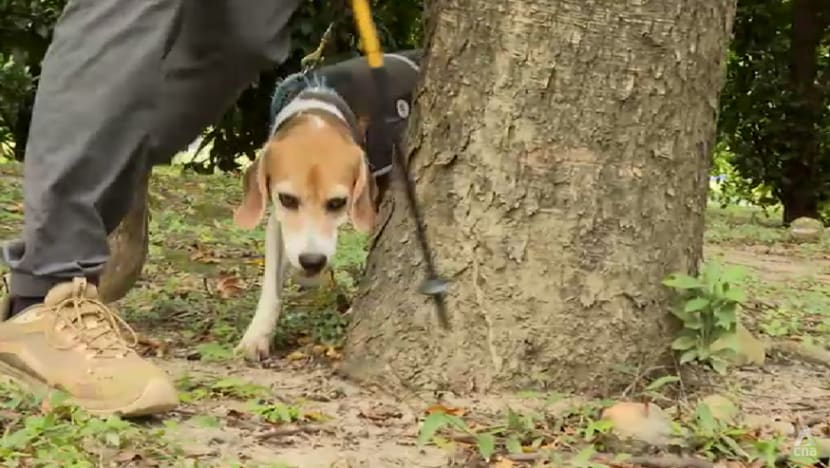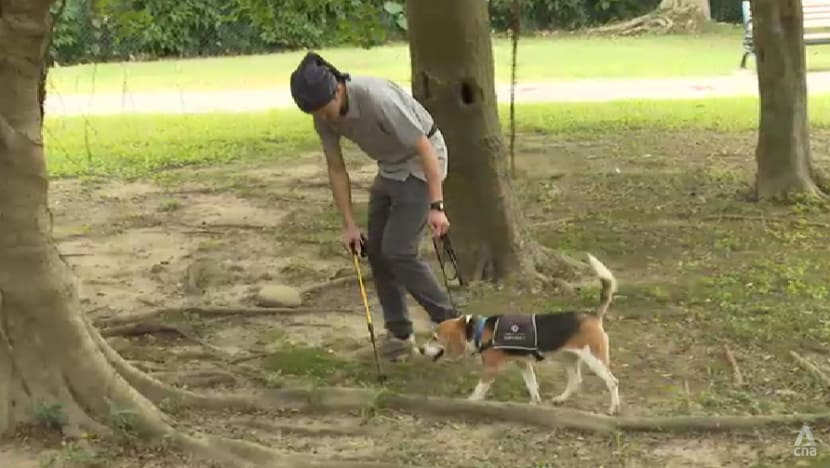Advertisement
East Asia
Each year, Taipei finds about 300 to 400 trees infected with the deadly brown root rot disease and around 30 per cent are detected by sniffer dogs.

Lucy, a 9-year-old beagle with a nose for finding sick trees, sniffs out the deadly brown root rot disease that has been plaguing Taipei’s urban forests.
New: You can now listen to articles. 
This audio is generated by an AI tool.

21 Dec 2024 08:49AM
TAIPEI: Since she was just a year old, Lucy the beagle has been roaming around Taipei every day to sniff out trees that need help.
She specialises in detecting the deadly brown root rot disease that attacks roots and cuts off the water and nutrient supply to a tree’s branches and leaves.
The fungal infection that has been plaguing Taipei’s urban forests can cause trees to decay and die.
It is responsible for 90 per cent of tree collapses in the Taiwanese capital, outside of the typhoon season.
Falling trees can cause injuries and even death, especially in a bustling city like Taipei, which has a population of about 2.5 million.
HOW CANINES KEEP THE CITY SAFE
Gentle and good-natured, Lucy is part of an elite team of sniffer dogs, specially selected and trained for the job.
When she gets a whiff of the scent of the disease, she sits next to the tree to indicate her find.
It takes at least two detection canines to confirm a diagnosis.
“Once one dog detects a positive tree, we will deploy a second dog to double-check. If both dogs sit down by the tree, then we can be quite certain that the tree is sick,” said Sung Fu-hua, director of the Taipei City government’s Floriculture Experiment Center.
There are about 200,000 trees across Taipei, and Lucy and her team can inspect around 8,000 trees per year.

Each year, the city finds about 300 to 400 infected trees and around 30 per cent are detected by sniffer dogs.
“The advantage of sniffer dogs is their speed in scouting large areas for the disease,” said sniffer dog trainer Chi Wen-hao.
“Once detected, we can test the tree to confirm if it is infected, significantly increasing efficiency.”
ELITE SQUAD OF CANINES
Brown root rot disease is particularly challenging to detect because it starts underground, at the trees’ roots.
By the time symptoms become apparent, it is often too late to save the trees.

Hence, sniffer dogs like Lucy play a crucial role in the city’s fight against sick trees.
Sung said there are strict requirements for selecting and training sniffer dogs.
“The beagle must have a sharp sense of smell, a stable temperament and a strong craving for treats as rewards. So far, only one out of 10 beagles can make the cut,” she told CNA.
Despite the challenges, the government wants to expand its canine detection team, recognising the unique role these dogs play in urban safety.
It plans to double the funding for the canine squad to US$90,000 next year, with a new pair of dogs joining the force in March.
